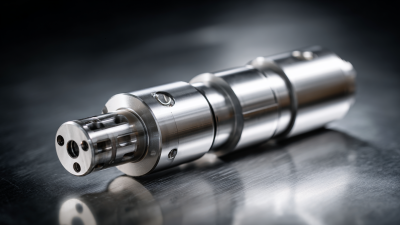Ultimate Guide to Choosing PPSU PEX Fittings for Maximum Durability and Performance
In recent years, the demand for high-quality plumbing solutions has surged, leading to an increased interest in Ppsu Pex Fittings due to their superior durability and performance compared to traditional materials. According to a 2022 industry report by IBISWorld, the global plumbing fittings market is projected to grow at a CAGR of 5.4%, driven by advancements in materials and technology. PPSU (Polyphenylsulfone) PEX fittings stand out for their resistance to high temperatures and chemicals, making them an ideal choice for diverse applications, from residential plumbing to commercial installations. This article aims to provide a comprehensive comparison of various Ppsu Pex Fittings, highlighting their unique features and benefits to help consumers make informed decisions that ensure longevity and efficiency in their plumbing systems.

Understanding PPSU and Its Benefits in PEX Fittings
PPSU, or Polyphenylsulfone, is a thermoplastic material gaining recognition for its exceptional properties in the production of PEX fittings. This high-performance polymer stands out due to its remarkable heat resistance and mechanical strength, making it ideal for plumbing and heating systems. Unlike traditional materials, PPSU can withstand high temperatures and pressure without compromising its structural integrity, ensuring longevity and reliability in various applications.
The primary benefits of using PPSU in PEX fittings include its superior resistance to chemical degradation and ability to maintain performance under extreme conditions. This means that PPSU fittings are less likely to corrode or fail over time, providing homeowners and contractors with peace of mind. Additionally, PPSU is lightweight and easy to install, enhancing both productivity and efficiency in construction projects. With its combination of durability and high performance, PPSU is becoming a popular choice for those seeking reliable solutions in plumbing infrastructure.

Key Factors to Consider When Choosing PPSU PEX Fittings
When selecting PPSU PEX fittings, understanding key factors can significantly influence both durability and performance. A recent industry report indicates that PPSU (Polyphenylsulfone) offers superior thermal and chemical resistance compared to traditional PEX materials. This makes it an excellent choice for applications involving varying temperatures and potential exposure to harsh chemicals, reinforcing its role in long-lasting plumbing systems.
Another critical factor to consider is the fitting's design and compatibility. Research has shown that fittings that adhere to standardized dimensions ensure better sealing and reduced risk of leaks. For instance, data reveals that precision manufacturing can lower the failure rate of fittings by up to 25%, making it essential to choose products from reputable manufacturers that adhere to stringent testing protocols. Additionally, the ease of installation plays a crucial role; fittings that support quick-connect designs can significantly reduce labor time and allow for more efficient plumbing installations, further enhancing overall system reliability.

Comparing PPSU PEX Fittings with Traditional Materials
When selecting plumbing materials, the choice between PPSU PEX fittings and traditional materials such as copper or PVC can significantly impact both durability and performance. PPSU (polyphenylsulfone) is known for its exceptional strength and resistance to high temperatures, making it an ideal choice for systems requiring high-pressure handling. According to a report by the International Association of Plumbing and Mechanical Officials (IAPMO), PPSU can withstand temperatures up to 200°C, significantly higher than the maximum temperature rating of standard PVC, which is around 60°C. This thermal resilience ensures that PPSU fittings maintain structural integrity under extreme conditions.
Furthermore, traditional materials like copper are prone to corrosion over time, especially in aggressive water conditions. A study from the Water Research Foundation indicates that copper can exhibit corrosion rates of up to 2.5 mm annually in certain environments, leading to potential leaks and system failures. In contrast, PPSU PEX fittings are engineered to resist corrosion and scaling, offering a lifespan that can exceed 50 years with proper maintenance. As the plumbing industry increasingly shifts toward innovative materials, the advantages of PPSU PEX fittings become clear, offering not only durability but also long-term cost savings due to reduced maintenance and replacement needs.
Comparison of PPSU PEX Fittings and Traditional Materials
Tips for Ensuring Longevity and Performance of PEX Systems
When selecting PPSU PEX fittings for your plumbing system, it is essential to focus on longevity and performance to ensure an efficient operation over time. PPSU, or Polyphenylsulfone, is known for its high resistance to heat and impact, making it a superior choice for PEX applications. To maximize the durability of your PEX system, consider fittings that are well-designed to minimize leaks and withstand high-pressure environments. Regular maintenance checks can also help identify any signs of wear or failure before they escalate into more significant issues.
In addition, the installation process plays a crucial role in the overall performance of PEX systems. Ensure that all fittings are properly secured and aligned to prevent stress on the joints. Utilizing radiant cooling systems can further enhance the efficiency of your PEX setup, as they have been shown to reduce electricity costs for cooling by up to 50% compared to traditional all-air systems. By investing in high-quality fittings and adhering to best installation practices, you can significantly enhance the functionality and lifespan of your PEX plumbing, enabling long-term cost savings and operational efficiency.
Common Mistakes to Avoid When Selecting PPSU PEX Fittings
When selecting PPSU PEX fittings, avoiding common mistakes can significantly enhance system durability and performance. One prevalent error is overlooking the temperature and pressure ratings of the fittings. According to a recent industry report by the Plastic Pipe and Fittings Association (PPFA), PPSU PEX fittings can withstand temperatures up to 200°F and pressures of at least 80 psi. Choosing fittings that exceed these benchmarks ensures longevity and reliability in a variety of applications, particularly in high-demand environments.
Another crucial mistake is failing to consider compatibility with other plumbing components. Data from the American Society of Mechanical Engineers (ASME) highlights that improper material pairing can lead to corrosion and material degradation, compromising the entire system. Ensuring that PPSU PEX fittings are compatible with existing plumbing materials not only prevents premature failure but also ensures optimal hydraulic performance. This highlights the importance of thorough research and consultation with manufacturers to ensure a successful installation that meets industry standards.
Related Posts
-

Ensuring Excellence in Manufacturing Standards for Best Ppsu Pex Fittings
-

How to Select the Best OEM Precision Parts for Your Manufacturing Needs
-

The Future of Innovation in Ball Valve Technology
-

Discover Innovative Examples of Quick And Easy Fittings Solutions
-

Essential Checklist for Choosing the Right Brass Elbow for Your Project
-

The Ultimate Guide to Sourcing High-Quality Brass Fittings for Your Business Needs
